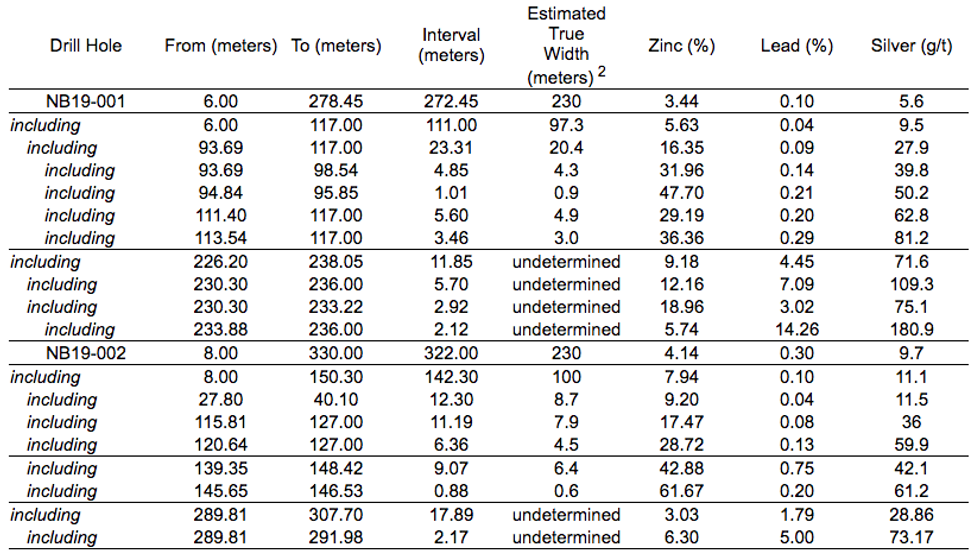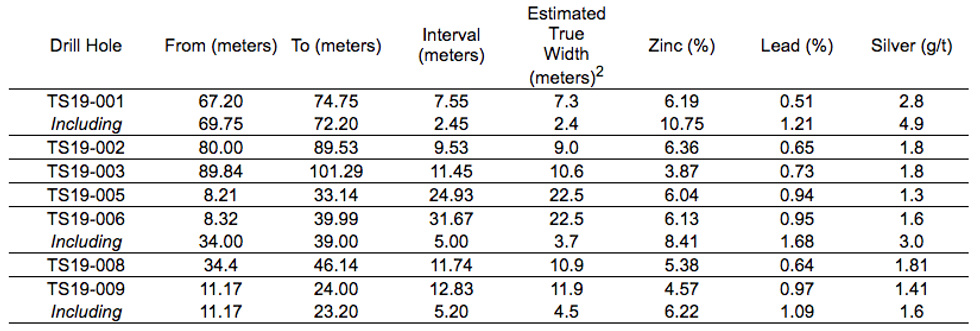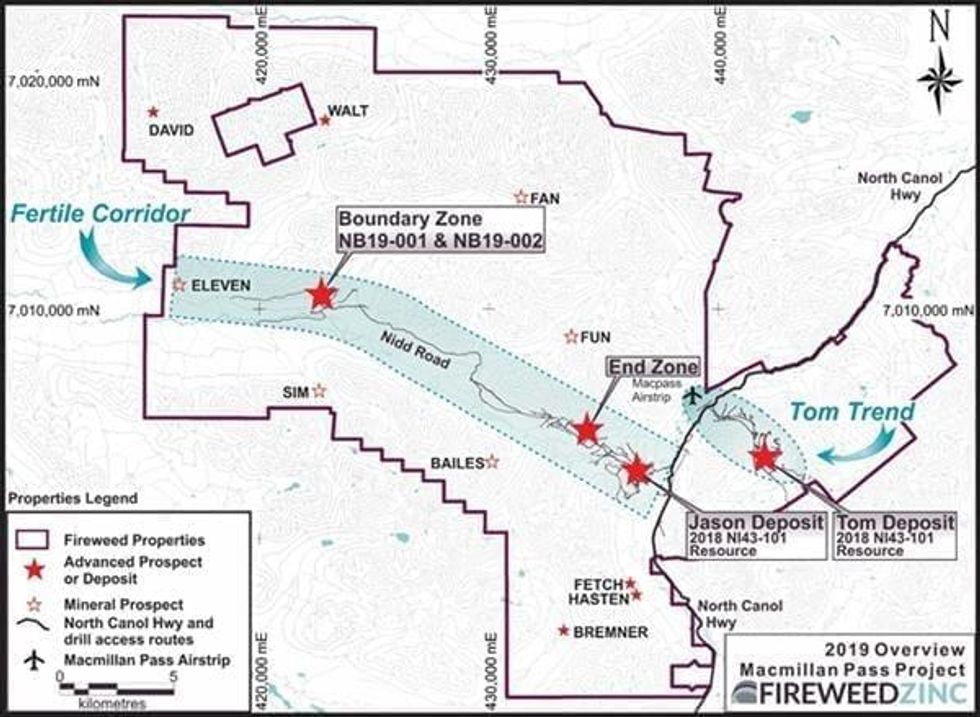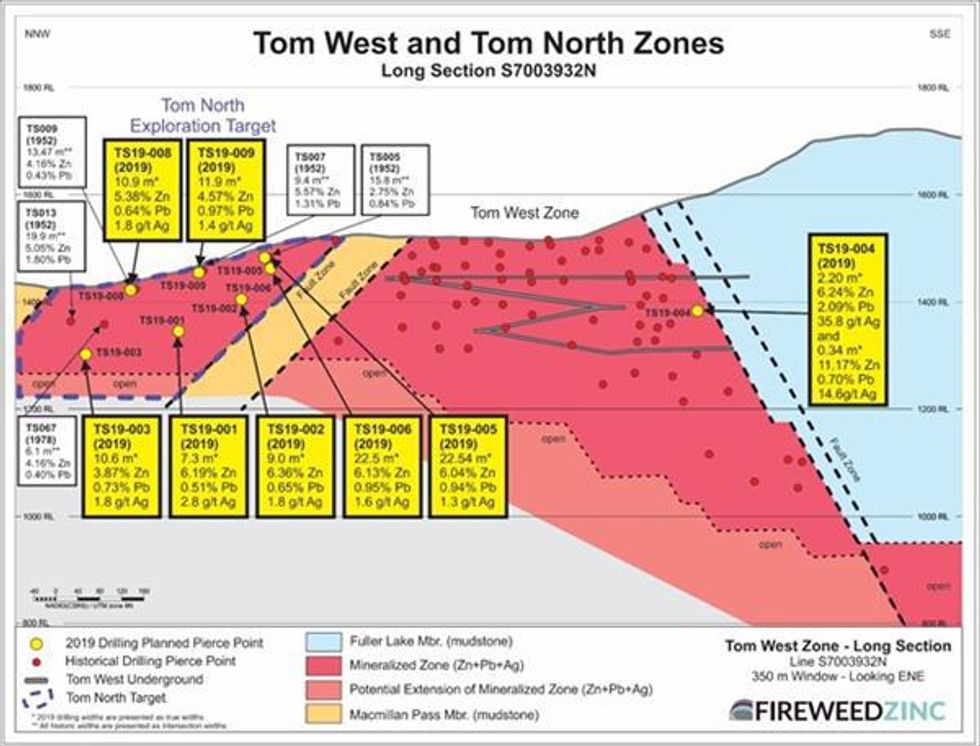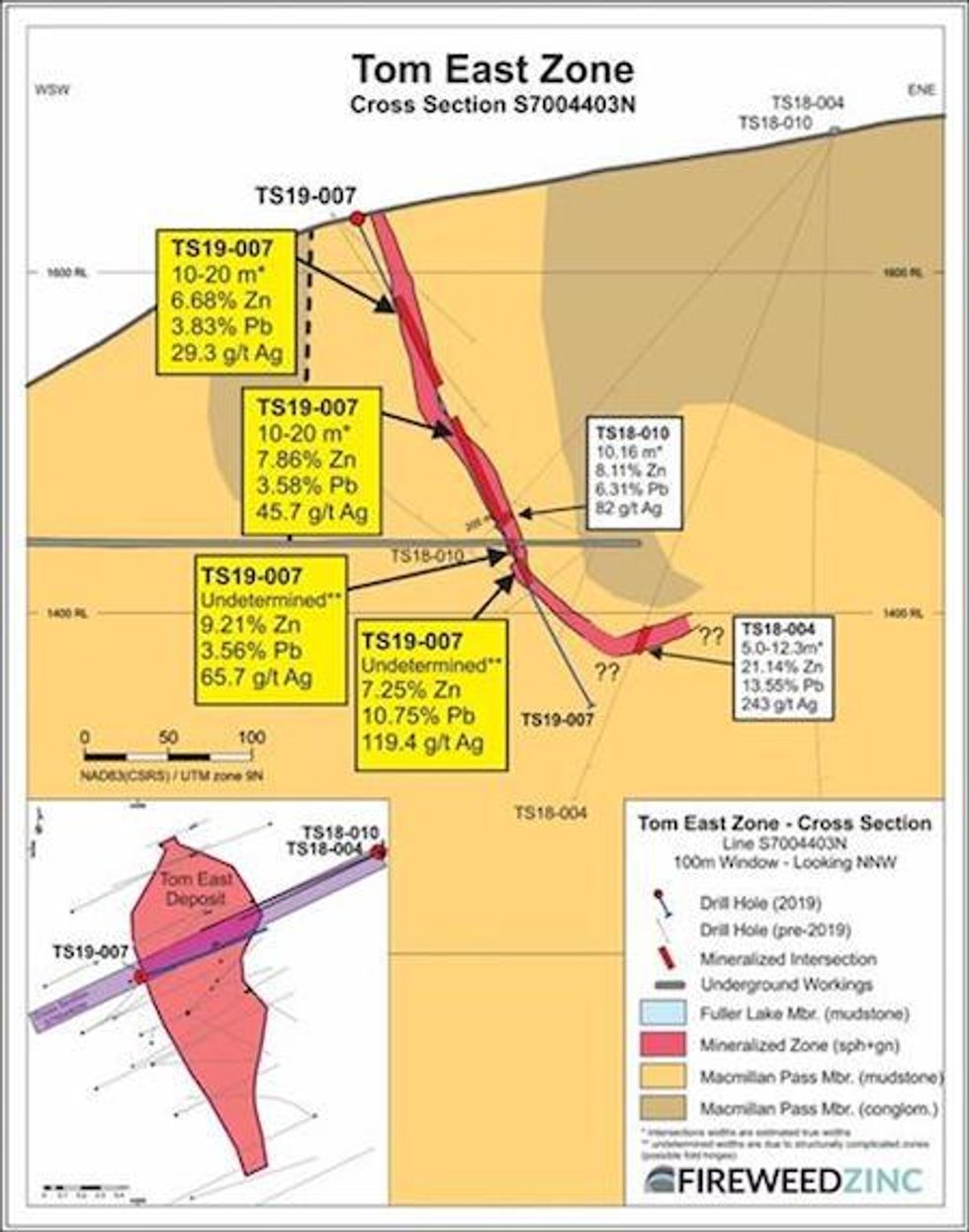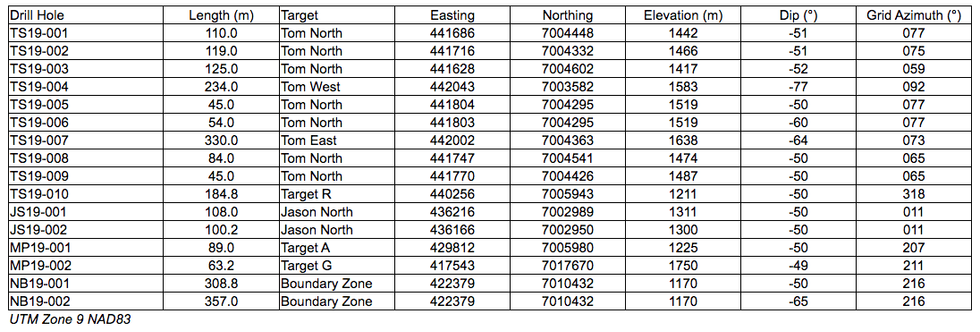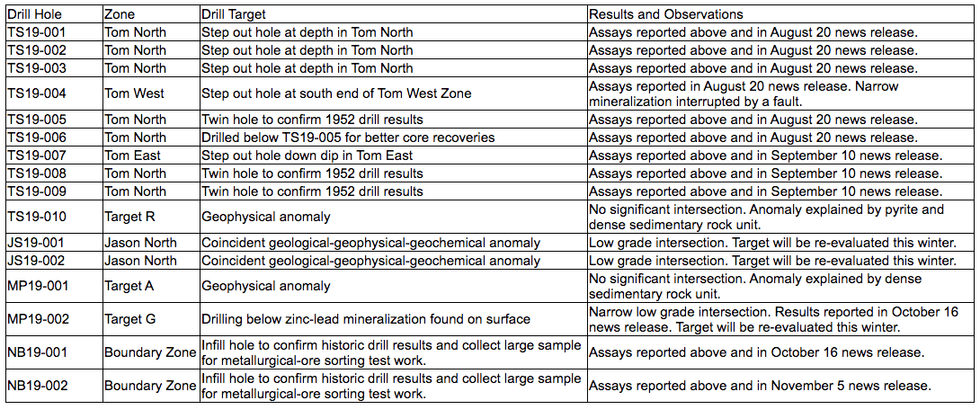Fireweed Zinc Provides Year-End Review of 2019 Accomplishments

Fireweed Zinc is pleased to provide a year-end review of its 2019 results and work program on the large Macmillan Pass Zinc Project in Yukon, Canada.
Fireweed Zinc Ltd. (“Fireweed” or the “Company”) (TSXV:FWZ) is pleased to provide a year-end review of its 2019 results and work program on the large Macmillan Pass Zinc Project in Yukon, Canada.
Highlights for 2019
- Drilling at Boundary Zone intersected wide zones of potential open pit mineralization. Highlights are 100 metres of 7.94% zinc from surface including 6.4 metres of 42.88% zinc within 230 metres of 4.14% zinc.
- Initial ore sorting test results indicate Boundary mineralization may be amenable to low cost upgrading prior to processing. Commercial-scale ore sorting and metallurgical test work is planned for 2020.
- Drilling at Tom North intersected potential open pit grades on the north extension of the large Tom West Zone. Highlights included 22.5 metres of 6.13% zinc and 0.95% lead from near surface.
- Geophysical ground gravity and passive seismic surveys, geological mapping and geochemical sampling were carried out to identify additional targets for exploration.
CEO Statement
After reviewing these year-end results, Fireweed CEO Brandon Macdonald stated “It has been another great year for Fireweed at Macmillan Pass highlighted by excellent results on several targets.
“Building on the 2018 Mineral Resource study which established Tom and Jason as one of the largest undeveloped zinc resources in the world and results of our PEA study which show the project to have robust economics, 2019 successfully continued to advance the project and expand the upside potential in areas beyond the known resources.
“The prime 2019 highlight was drilling of our first holes at Boundary Zone and we were rewarded with very wide intersections of excellent open pit grades, and geological indications this may be a large feeder zone to yet undiscovered stratiform mineralization. Successful initial tests also indicate strong potential to upgrade Boundary mineralization through low cost ore sorting technology and significantly impact overall project economics. In 2020 we also plan to drill at Boundary toward an initial NI43-101 compliant mineral resource. Other 2019 drilling outlined potential open pit mineralization at Tom North and we continued to intersect high grades at Tom East. We plan another active season in 2020 and will provide details when plans and budgets are finalized.
“I want to personally thank our talented and hard-working team for all their great work in 2019 and thank our First Nations partners for their support, guidance and valuable contributions. We all look forward to another year of major accomplishments in 2020.”
2019 Drilling Highlights
In 2019 a total of 16 diamond drill holes were drilled for a total of 2,357 metres at the Macmillan Pass Project. Background and drill results from the 2019 program were as follows (see Figure 1 for locations):
Boundary Zone Background and 2019 Drilling
Historic drilling of 24 holes at Boundary Zone indicates the presence of a large bulk tonnage zone of zinc (-lead-silver) mineralization potentially amenable to open pit mining. The 2019 Boundary drill program was designed to infill a gap in historic drilling (see Figure 2) and obtain a bulk sample for commercial-scale ore sorting and metallurgical test work (see below). No mineral resource has been estimated for Boundary Zone yet and the zone is not included in the current mineral resource estimate for the property (described in Fireweed news release dated January 10, 2018). The objectives of recent and continuing work at Boundary Zone is toward estimation of an initial mineral resource followed by an economic study as well as continued exploration for new discoveries in the area.
Known mineralization is spread over an area almost two kilometres long and 200 to 800 metres wide. Mineralization drilled in a central area is 350 metres long and has a true thickness of up to 250 metres with historic drilling grades averaging 2.0 ‑ 2.5% zinc1 that include multiple higher grade intervals closer to surface similar to the holes reported below from 2019 (see Figures 2 & 3 and Fireweed news release dated November 6, 2018). Higher grades near surface are favourable for potential open pit mining economics. The zone has been drilled up to 285 metres down dip and remains open to depth and along trend for further exploration.
Boundary Zone mineralization consists of sphalerite-siderite-pyrite and minor galena in veins, stockworks, disseminations, and as replacement of matrix and clasts within coarse clastic rocks that are interpreted to represent subsurface “feeder” mineralization to potential, as yet undiscovered, stratiform mineralization similar in style to Tom or Jason.
TABLE 1: 2019 BOUNDARY ZONE DRILL RESULTS
Boundary Zone Ore Sorting Tests
Initial ore sorting test results for Boundary Zone reported in 2019 indicate Boundary Zone mineralization is potentially amendable to low cost, state-of-the-art X-Ray Fluorescence (“XRF”) ore sorting processing technology (see Fireweed news release dated July 31, 2019 for details). These test results rejected 50-70% of the waste material (30-50% mass pull), while recovering 80-85% of the zinc. In practical terms, these results show potential to upgrade mill feed from the test feed grade of 2.5% zinc to approximately 5% zinc with recovery of 80-85% of the zinc at low cost. Two tonnes of core samples from the two 2019 Boundary drill holes have been collected to carry out planned commercial-scale ore sorting and metallurgical tests in 2020. If these tests confirm the initial ore sorting results, they have the potential to significantly improve economics of the Macmillan Pass Project.
Tom North Drilling
Historic trenching and very shallow, low-recovery drilling in 1952 indicated the presence of near-surface mineralization at Tom North. The 2019 drilling at Tom North confirmed that mineralization extends to depth, and the results define a near-surface zone of zinc-lead mineralization that is potentially amenable to open‑pit mining. The Tom North target has mineralization demonstrated over a strike length of at least 500 metres, and a true thickness between 6 and 23 metres (average of 12 metres). The down-dip extent has been tested to 190 metres and remains open to depth (see Figure 4). The mineralization is stratiform and comprises laminated fine-grained sphalerite-galena-pyrite-barite. Tom North is a distinct zone separated from the Tom West zone by faulting (see Figure 4).
No mineral resource has been estimated for Tom North yet and the zone is not included in the current mineral resource estimate for the property (described in Fireweed news release dated January 10, 2018). Tom North represents potential for a significant expansion to Tom mineral resources, for extension of open-pit and underground mine life, and improvement of project economics described in the current Preliminary Economic Assessment (“PEA”) (see Fireweed news release dated May 23, 2018). The current PEA includes an initial three-year open-pit mine life at Tom West over the course of an overall 18-year mine life.
TABLE 2: 2019 TOM NORTH DRILL RESULTS
Tom East Drilling
Tom East is the highest grade zone discovered on the property to date. In 2018, drilling extended the zone to depth with the deepest hole intersecting 16.4 m grading 21.14% Zinc, 13.55% Lead and 243 g/t Silver (Figure 5; see Fireweed news release dated September 20, 2018 for details). 2019 drill hole TS19-007 was planned to test the potential extension of the zone but the hole deviated from its planned course and drilled multiple down-dip intersections passing in and out of mineralization at very low angles to the zone. These high-grade infill results provide geological information that will inform geological modelling for resource expansion and exploration in the structurally complex Tom East zone (see Figure 5). The potential extension of the high-grade mineralization discovered in 2018 remains untested and Tom East is open at depth
TABLE 3: 2019 TOM EAST DRILL RESULTS
Field Work
Field work in 2019 consisted of continued geological mapping, geophysical surveying accompanied by passive seismics, and geochemical sampling mainly in the Tom, Jason, Boundary and MC claims areas to understand the geology and controls on mineralization, and identify additional exploration targets. Geophysics crews continued work west along the Fertile Corridor between End Zone and Boundary Zone (see Figure 1) and identified additional gravity anomalies for future follow up. Geological mapping and geochemical sampling were carried out over many parts of the property. An airborne LiDAR topographic survey of the entire property was also completed. Receipt of final LiDAR maps, which will aid in geological interpretation, accurate location of work sites, engineering and wildlife studies, are expected this month. Currently, interpretation of the results of the mapping, geochemistry and geophysics work from the 2019 field season are being carried out toward identifying high priority areas for exploration toward future new discoveries.
Access Road Update
Access to the project site is via Yukon Highway 6 (aka the North Canol Road) and an airstrip on the property. As described in the PEA study (see Fireweed news release May 23, 2018 and PEA report filed on www.sedar.com), any future mining operation will require upgrading of the road to accommodate more traffic. Fireweed is pleased to report that during the past summer the Yukon Department of Highways and Public Works carried out additional work on the road which included replacement of three more bridges and various road repairs. Three additional new prefabricated bridges have also been delivered to the start of the road and are available for installation next year. The continuing active support of the Yukon government on the Macmillan Pass Project is but one indication of why Yukon is a top 10 mining investment jurisdiction in the world as designated by the Fraser Institute.
Permitting Update
In November the Company received a new Class 4 permit valid until 2028 that allows for larger exploration programs including a 150‑person camp as well as expanded drilling and exploration activities in the Tom, Jason and End Zone areas. Other parts of the property will continue to be explored under a Class 1 permit in 2020.
Future Plans
Plans for an active 2020 exploration program will include drilling in the Boundary Zone to define NI43‑101 compliant mineral resources and exploration in the general Boundary Zone area for additional mineralization including potential undiscovered stratiform zone(s) that may have been generated by the currently known extensive Boundary Zone “feeder” mineralization. Other plans may include drilling of further step out holes, drilling of new exploration targets and field work toward development of additional exploration targets on the large property. Details of 2020 work plans will be announced when the interpretation of 2019 field work is completed and budgets are approved.
Qualified Person Statement
Technical information in this news release has been approved by Gilles Dessureau, P.Geo, Vice President Exploration and a ‘Qualified Person’ as defined under Canadian National Instrument 43‑101.
About Fireweed Zinc Ltd. (TSXV: FWZ): Fireweed Zinc is a public mineral exploration company focused on zinc and managed by a veteran team of mining industry professionals. The Company is advancing its district-scale 544 km2 Macmillan Pass Project in Yukon, Canada, which is host to the 100% owned Tom and Jason zinc-lead-silver deposits with current Mineral Resources and a PEA economic study (see Fireweed news releases dated January 10, 2018, and May 23, 2018, respectively, and reports filed on www.sedar.com for details) as well as the Boundary Zone, Tom North Zone and End Zone which have significant zinc-lead-silver mineralization drilled but not yet classified as mineral resources. The project also includes option agreements on large blocks of adjacent claims (MAC, MC, MP, Jerry, BR and NS) which cover exploration targets in the district where previous and recent work identified zinc, lead and silver prospects, and geophysical and geochemical anomalies in prospective host geology.
Additional information about Fireweed Zinc and its Macmillan Pass Zinc Project including maps and drill sections can be found on the Company’s website at www.FireweedZinc.com and at www.sedar.com.
ON BEHALF OF FIREWEED ZINC LTD.
“Brandon Macdonald”
CEO & Director
Contact:
Brandon Macdonald
Phone: 604-696-8361
Neither the TSX Venture Exchange nor its Regulation Services Provider (as that term is defined in the policies of the TSX Venture Exchange) accepts responsibility for the adequacy or accuracy of this release.
Cautionary Statements
This news release may contain “forward-looking” statements and information relating to the Company and the Macmillan Pass Project that are based on the beliefs of Company management, as well as assumptions made by and information currently available to Company management. Such statements reflect the current risks, uncertainties and assumptions related to certain factors including but not limited to, without limitations, exploration and development risks, expenditure and financing requirements, general economic conditions, changes in financial markets, the ability to properly and efficiently staff the Company’s operations, the sufficiency of working capital and funding for continued operations, title matters, First Nations relations, operating hazards, political and economic factors, competitive factors, metal prices, relationships with vendors and strategic partners, governmental regulations and oversight, permitting, seasonality and weather, technological change, industry practices, and one-time events. Additional risks are set out in the Company’s prospectus dated May 9, 2017, and filed under the Company’s profile on SEDAR at www.sedar.com. Should any one or more risks or uncertainties materialize or change, or should any underlying assumptions prove incorrect, actual results and forward-looking statements may vary materially from those described herein. The Company does not undertake to update forward‐looking statements or forward‐looking information, except as required by law.
Footnotes:
- Historic results for the Boundary Zone reported in this news release are taken from historic reports prepared by previous operators. Neither the Company or the Qualified Person has done sufficient work to verify these results and therefore these results should not be relied upon. The Company is including them for information purposes to explain the basis for the exploration target and reasons for exploring and drilling.
- Estimation of true widths of intervals in the drill results tables is based on preliminary geological interpretation of historic and new drilling data.
- Drill hole TS19-007 at Tom East deviated from its planned course and drilled down dip in the Tom East Zone resulting in multiple intersections as the drill bit cut in and out of the zone. Estimated true widths in Table 1 are based on the projection of the zone contacts, oriented core bedding measurements, and other nearby drill intersections that intersect the zone at higher angles.
- Additional details on these drill intersections, and sampling and assay methods are noted in the 2019 Fireweed news releases.
FIGURE 1: MACMILLAN PASS PROJECT MINERALIZATION SHOWING LOCATION OF TOM, JASON, BOUNDARY AND END ZONES
FIGURE 2: BOUNDARY ZONE GEOLOGY, MINERALIZATION AND DRILL HOLES
FIGURE 3: BOUNDARY ZONE CROSS SECTION WITH 2019 DRILL HOLES
FIGURE 4: LONG SECTION OF TOM NORTH AND TOM WEST HISTORIC1 AND 2019 DRILL RESULTS
FIGURE 5: TOM EAST CROSS SECTION
TABLE 4: 2019 DRILL HOLE COLLAR DATA
TABLE 5: 2019 DRILL HOLE RESULTS SUMMARY AND OBSERVATIONS
Click here to connect with Fireweed Zinc Ltd. (TSXV:FWZ) for an Investor Presentation.
